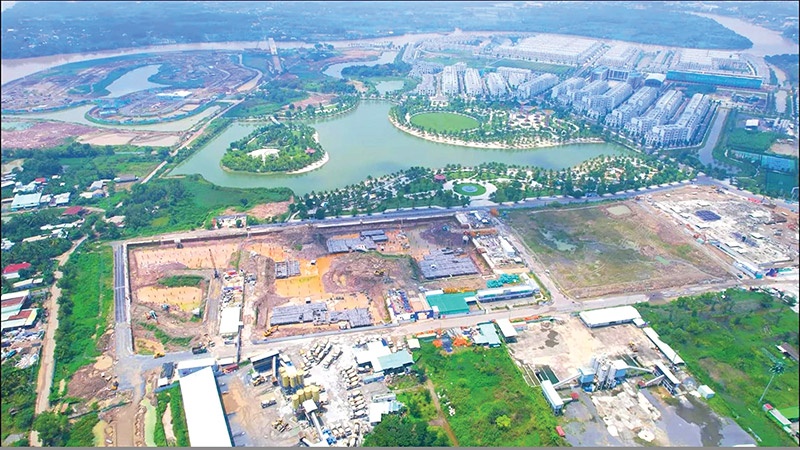Ensuring land prices on market principles
One of the new issues stemming from Resolution No.18-NQ/TW dated June 16, on the effectiveness of management and use of land, is the removal of the land price bracket and the mechanism and methods for determining land prices under market rules, according to experts and gathered through public opinion.
 |
| Ensuring land prices on market principles |
The land market of Vietnam has long existed as a dual-price mechanism. One is the land price according to the framework promulgated by the government every five years. From this framework, local people’s committees set up their own price lists for compensating people whose land is repossessed.
The second is the market price – the price traded directly on the market between the seller and the buyer, and the market price is always much higher than the local people’s committees’ set-up prices.
According to Assoc Prof. Dr. Nguyen Dinh Tho, general director of the Institute of Strategy and Policy on Natural Resources and Environment, the 2013 Law on Land stipulates that the land price in the framework must be equal to the market price, but in fact, is much lower than the market price. “The current land price framework of most localities is 30-60 per cent lower than the market price,” Tho said.
Thus, according to Resolution 18, removing the land price bracket will destroy the difference between the dual-land price mechanisms. From there, the land price will be decided by the market and ensure better benefits for people whose land is repossessed helping to speed up projects’ implementation.
At a national conference on research, study, and implementation of Resolution 18 held in July, Prime Minister Pham Minh Chinh said that the new breakthrough of the resolution is to remove the land price framework and stipulate a higher tax rate for users of many land areas, homes, and land speculation.
This is a matter of special concern, the prime minister emphasised, noting that the determination of land prices still has many shortcomings that lead to mistakes and losses in the state budget. “The breakthrough new point of Resolution 18 is to remove the land price framework and to have a mechanism and method for determining land prices according to market principles,” the PM said. “It also clearer stipulates the functions, tasks, and responsibilities of competent agencies on land price determination.”
Land price difference
The big gap between the provincial land price framework and the price in the real market led to the compensation price being determined also much lower and causes prolonged complaints and lawsuits from local people. For example, a project to restore and embellish the headquarters of the Supreme People’s Court located in Hoan Kiem district in Hanoi has hit a snag in recent times. Hoan Kiem People’s Committee applied the maximum compensation and incentives to the owners of the land whose land was repossessed and at the same time, applied a specific mechanism to ensure the interests of the people at the highest level. However, the price framework set by the state was very different from the market price.
According to batdongsan.com.vn, some locations in the Hoan Kiem district are advertised for sale at prices of up to billions of VND (over $100,000) per square metre. Meanwhile, according to the land price list in Hanoi effective from 2020, the price in some locations in the district ranges around VND188-400 million ($8,100-17,400) per sq.m.
Meanwhile, the framework of Ho Chi Minh City issued in 2015 determined some locations in District 1 to be around VND150 million ($6,500). However, the real price is now advertised as up to VND1 billion ($43,500) per sq.m.
Professor Dang Hung Vo, former Deputy Minister of Natural Resources and Environment, said that the price gap causes many consequences, with the most serious being land corruption. “This is one of the loopholes leading to the loss of budget revenue. In addition, brokers have lined on the adjustment of the land price framework to spread false information, inflate prices, and create a virtual fever. Therefore, the removal of the land price framework is a breakthrough to bring the land price back to its real value, and prevent land corruption,” Vo said.
He also emphasised that although the removal of the land price framework is positive, the implementation has been very slow so far, and the next step should be the removal of the land price list and replacing it with a land value map.
Worries raised
Besides the positive points, many experts and investors are concerned that the removal of the land price framework may cause the input costs of projects to rise, pushing up house prices.
Nguyen Van Dinh, vice chairman of the Vietnam Real Estate Association, said input costs may increase, but investors will be proactive in calculating and making plans from the beginning, bringing greater economic efficiency.
“It is possible that house prices will be higher, but higher to a certain extent acceptable to the market, but at a reasonable level only,” Dinh said.
Meanwhile, Nguyen Van Hau, general director of Asian Holdings, said that the removal of the land price framework should only be related to the secondary transactions while uncertain effectiveness is determined for the compensation activities. “Currently, apart from depending on the land price framework, there are several methods of calculating land use fees such as direct comparison or surplus calculation. Many businesses apply the surplus method, which will generate a land use levy,” said Hau.
Nguyen Quoc Hiep, chairman of the Vietnam Contractors Association, suggested it is necessary to clearly define what is said to be the “common land price in the market” with fluctuations to serve as a basis for adjusting the price list.
“The price of land fluctuates daily based on many reasons, and there is a situation of deliberately expanding the price. If based on fluctuations, there is a risk of continuous adjustment, causing instability and making things more difficult for developers when compensating land,” he said.
For businesses that have accumulated land and prepared land funds for project development, the removal of the land price framework actually does not affect the selling price of their products. However, for businesses that have to find new land funds for developing projects, the removal of the land price framework will be a factor that increases land costs, thereby potentially pushing up prices, according to Hiep.
| Ben Gray-Director of Capital Markets Knight Frank Vietnam
The current system used to determine land pricing when selling land to private individuals is centrally managed and does not provide the best value for people. In fact, under the existing guidelines, it is not uncommon for the land to be priced at one-tenth of the market value and, in some cases, as low as one-hundredth of the market value. This is clearly unsustainable and does not provide an incentive at the provincial level for land to be transferred from the state to private ownership, nor does it fairly compensate private land owners when their land is acquired by the state for infrastructure and development projects. Our analysis points to inefficiencies in all stages of the existing land value evaluation process that have direct government involvement – land price brackets, land price tables, and specific land prices. The main value determinants – the location, patterns of land use, and what can be built on it – are hyper-localised, requiring strong knowledge of the area in order to gauge the market value of property and land. The process begins with the state setting land price brackets that are then used as guidance by people’s committees at provincial level to determine land price tables. After localised input from the provincial department of natural resources and environment, prices for the area are officially set. The land reform proposal that will be presented to the National Assembly in October is understood to be recommending a shift from a top-down approach and administrative methods of centrally determining localised pricing to a market-based approach to determine the value of the land. The proposal is also understood to be recommending five methods of valuation to determine land prices, as well as a draft decree seeking to qualify how these can be applied based on specific conditions that can trigger the use of each method. What is not known is if this goes far enough to consider issues that can arise from parties seeking to negotiate land purchases. If the draft decree considers the methods of valuation allowing the state to achieve the highest value by, perhaps, leveraging off international standards, while ensuring that there is an efficient dispute management process in place, then the state will be able to benefit greatly from a well-defined and transparent system. | |
| Nguyen Hai Thao-Counsel, Mayer Brown Vietnam
The statutory land prices provided in the national framework and the provincial table have long been viewed as not up to date with the market, making it difficult for negotiating with land users whose (mostly agricultural) land is revoked for development projects. The draft amendments to the Law on Land, to replace the 2013 version, retains the provincial price table, which is supposed to be updated every year based on market price, in an attempt to bring statutory prices closer to the market. This is an improvement because it increases the frequency of updating the statutory prices, but not a breakthrough solution because this measure alone does not address the roots of the problem. Firstly, both the current land regulations and the draft law do not define “market”, while it is obvious that the unregulated market, where speculation is rampant, has a great impact overall, including the regulated market. Secondly, although a current decree defines what “market price” is by listing the sources where data on prices are collected, the data from these sources are not reliable. It has been longstanding malpractice by market participants, mostly in residential land, to inflate the asking price when selling and deflate the successful bid price when paying personal income tax for the same transaction. Therefore the transaction prices recorded with the tax and other authorities do not reflect truthfully the market price. Thirdly, when it comes to compensation for land revocation, the compensation amount is calculated based on agricultural land prices that are much lower than commercial or residential land prices to be applicable on the same land after it is converted to commercial or residential land. That demotivates farmers to relinquish their land and prolongs the revocation process. Bringing statutory land prices up to the market requires a concerted effort on a few fronts other than land regulations such as taxation (both legislation and enforcement) and overall market management measures to curb speculation. Nevertheless, the most important task for the drafters of the draft law is to define what the market actually is. |
 | Industrial park developers immune to COVID-19 Industrial park infrastructure development companies continue to do well amid the COVID-19 pandemic, and the industrial property sector is expected to thrive since Vietnam is considered among the most attractive investment destinations post-pandemic. |
 | Long Thanh International Airport hikes land prices in surroundings Starting the construction of Long Thanh International Airport doubled land and property prices in the surrounding areas over a year. |
 | Charting course of land price frenzy The State Bank of Vietnam is closely monitoring the real estate market to avoid any breakdowns as a large-scale land fever has gripped the country in recent months. Dr. Phan Minh Ngoc, senior credit research analyst at Bondcritic Ltd. in Singapore, writes about the ramifications of the situation. |
 | Nationwide momentum seen in land price and rental rates Despite external factors, industrial real estate in Vietnam still recorded good transactions in the first four months of the year. Paul Fisher, country head in Vietnam for JLL, shares his assessment on the potential of the industrial property sector in attracting large-scale foreign manufacturers. |
What the stars mean:
★ Poor ★ ★ Promising ★★★ Good ★★★★ Very good ★★★★★ Exceptional
Related Contents
Latest News
More News
- Sun Group breaks ground on $2 billion Van Don casino complex (December 19, 2025 | 18:14)
- Rare, beautiful, sustainable: the mark of iconic real estate (December 19, 2025 | 08:00)
- Owner-occupied housing stabilises, paving the way for new growth cycle (December 18, 2025 | 17:04)
- Unlocking urban potential of smart cities (December 18, 2025 | 16:50)
- Green finance offers 'passport' for Vietnamese construction, building materials firms (December 15, 2025 | 08:00)
- Gamuda Land commit long-term investment (December 12, 2025 | 11:49)
- HITC ties up with Evolution to develop AI and hyperscale data centres in Vietnam (December 11, 2025 | 12:09)
- Real estate deals boom via high-profile names (December 08, 2025 | 11:32)
- Industrial segment shaped by M&As (December 08, 2025 | 08:00)
- The Privé sets the benchmark for luxury real estate (December 05, 2025 | 08:28)



 Tag:
Tag:




















 Mobile Version
Mobile Version